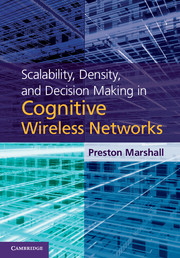Book contents
- Frontmatter
- Contents
- Preface
- Part I Overview
- 1 Introduction
- 2 Theoretical foundations
- 3 Future wireless operation, environments, and dynamic spectrum access
- 4 Some fundamental challenges in cognitive radio and wireless network systems
- Part II Generalized environmental characterization
- Part III System performance of cognitive wireless systems
- Part IV Integrated awareness and decision making
- Part V Summary
- Part VI Appendices
- Index
- References
1 - Introduction
from Part I - Overview
Published online by Cambridge University Press: 05 December 2012
- Frontmatter
- Contents
- Preface
- Part I Overview
- 1 Introduction
- 2 Theoretical foundations
- 3 Future wireless operation, environments, and dynamic spectrum access
- 4 Some fundamental challenges in cognitive radio and wireless network systems
- Part II Generalized environmental characterization
- Part III System performance of cognitive wireless systems
- Part IV Integrated awareness and decision making
- Part V Summary
- Part VI Appendices
- Index
- References
Summary
The challenge of dense and scalable wireless systems
For many decades wireless designers have focused on range and link performance. Communications systems were assessed in terms of their range and data-carrying capacity. Early cellular system designers and architects were concerned that the towers and base stations were assured to have sufficient range to provide complete coverage. However, the pervasiveness of wireless communications has almost reversed this consideration, and the emphasis in the development of wireless architectures must adapt itself to address fundamentally new technology objectives, since the success of future networks will be driven by network density and scalability.
While radio engineers once strove to achieve as much range as possible from radio systems, in an emerging wireless-dependent society, the need for high device and bandwidth density has begun to drive wireless communications in a reverse direction; stressing spectrum reuse through short-range, highly localized communication architectures. Some of these adaptions are apparent now: low-cost femtocells fill a service gap between taller and higher-power cellular base transceiver station (BTS) and towers, and the lower-power wireless local area network (LAN) installations. Others, such as flexible spectrum sharing, interference management, and heterogeneous networks are only emerging.
Future communications architectures are unlikely to be a choice among current cellular, wireless local area network (WLAN), peer-to-peer (P2P), and fixed modalities, but will be convergent to an integrated framework whose optimizing process will be so dynamic that it will be invisible to users.
Information
- Type
- Chapter
- Information
- Publisher: Cambridge University PressPrint publication year: 2012
References
Accessibility standard: Unknown
Why this information is here
This section outlines the accessibility features of this content - including support for screen readers, full keyboard navigation and high-contrast display options. This may not be relevant for you.Accessibility Information
- 1
- Cited by
